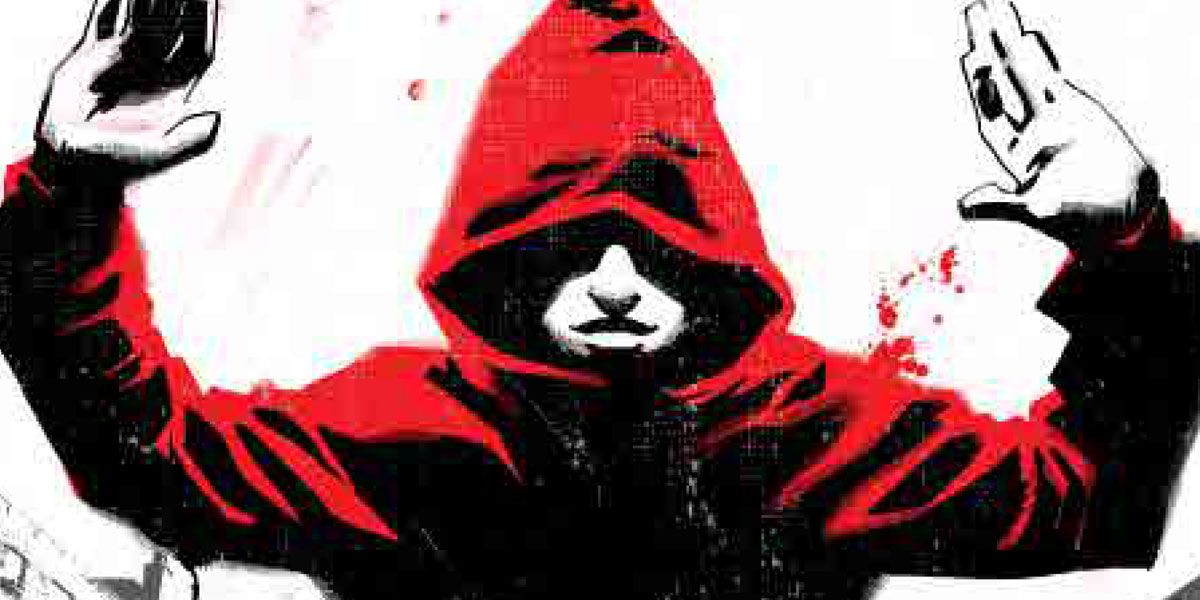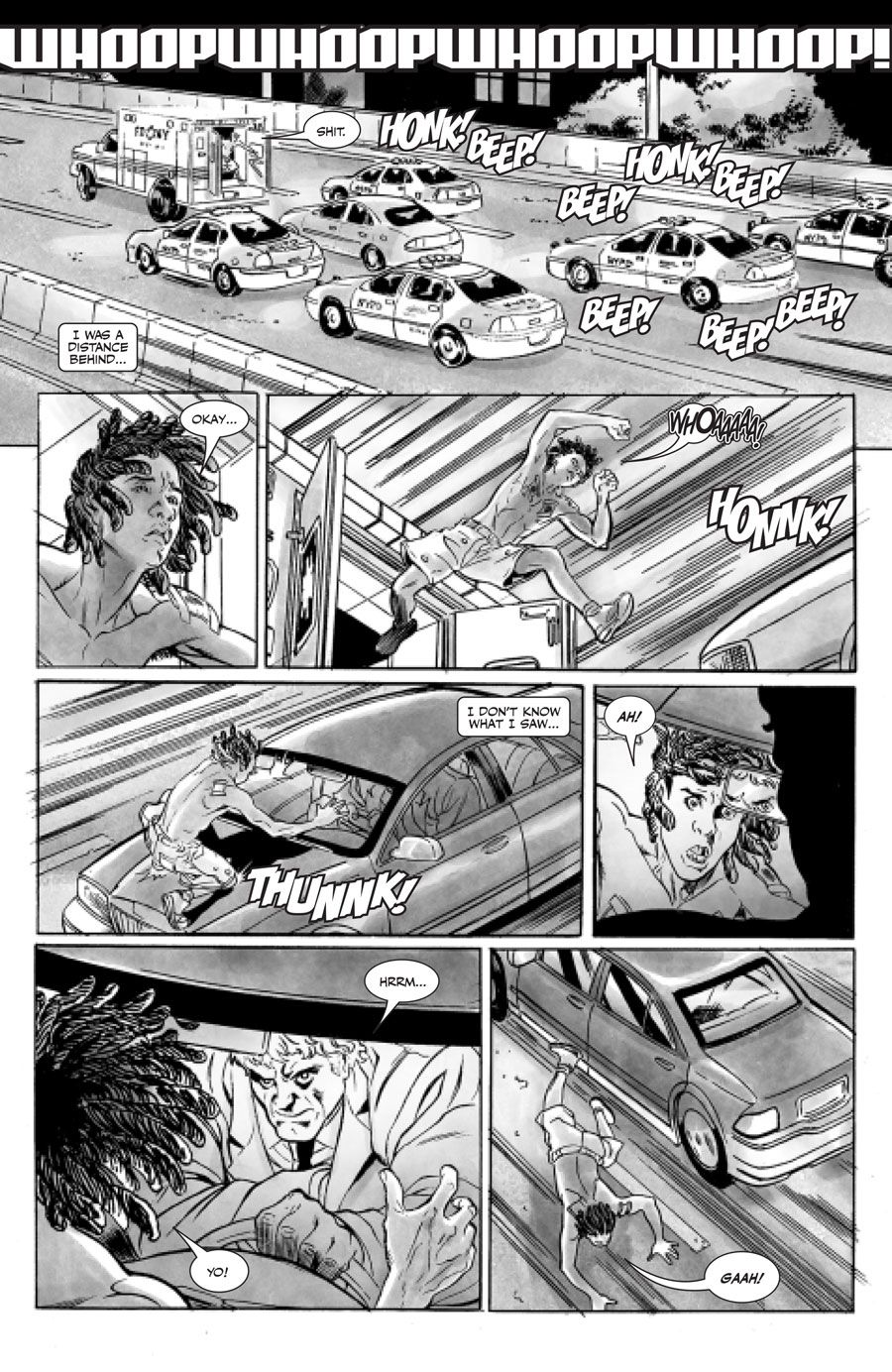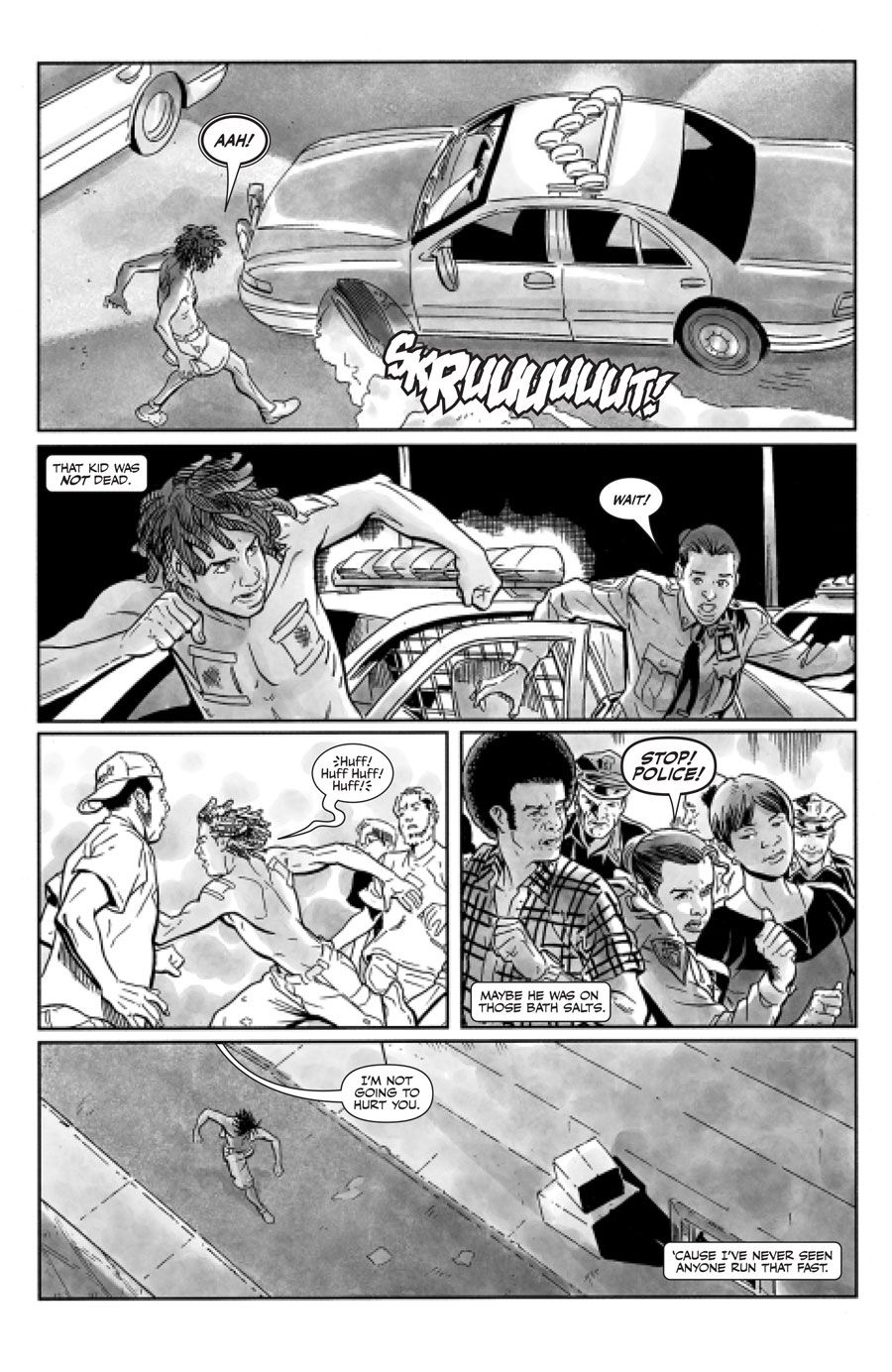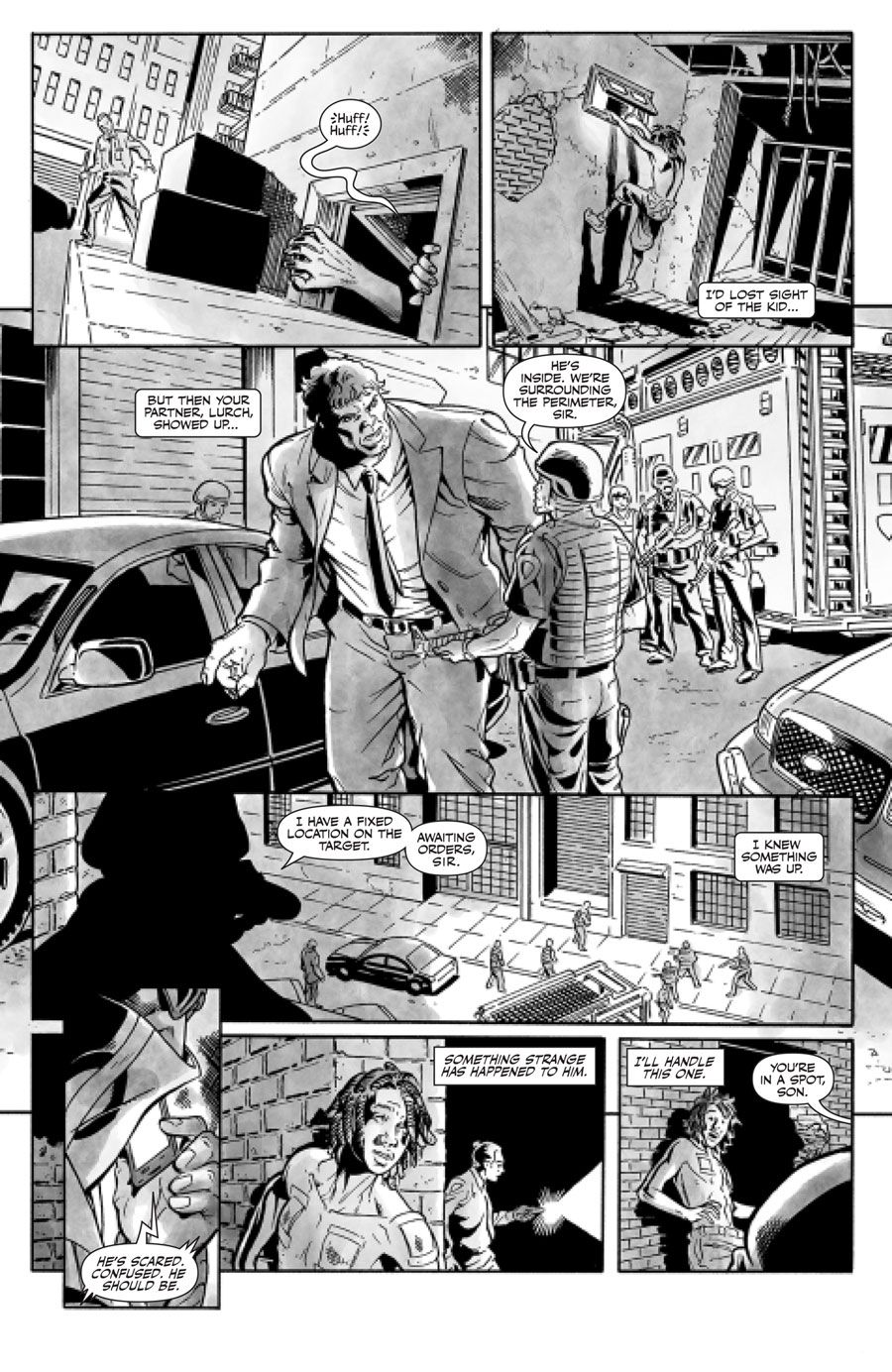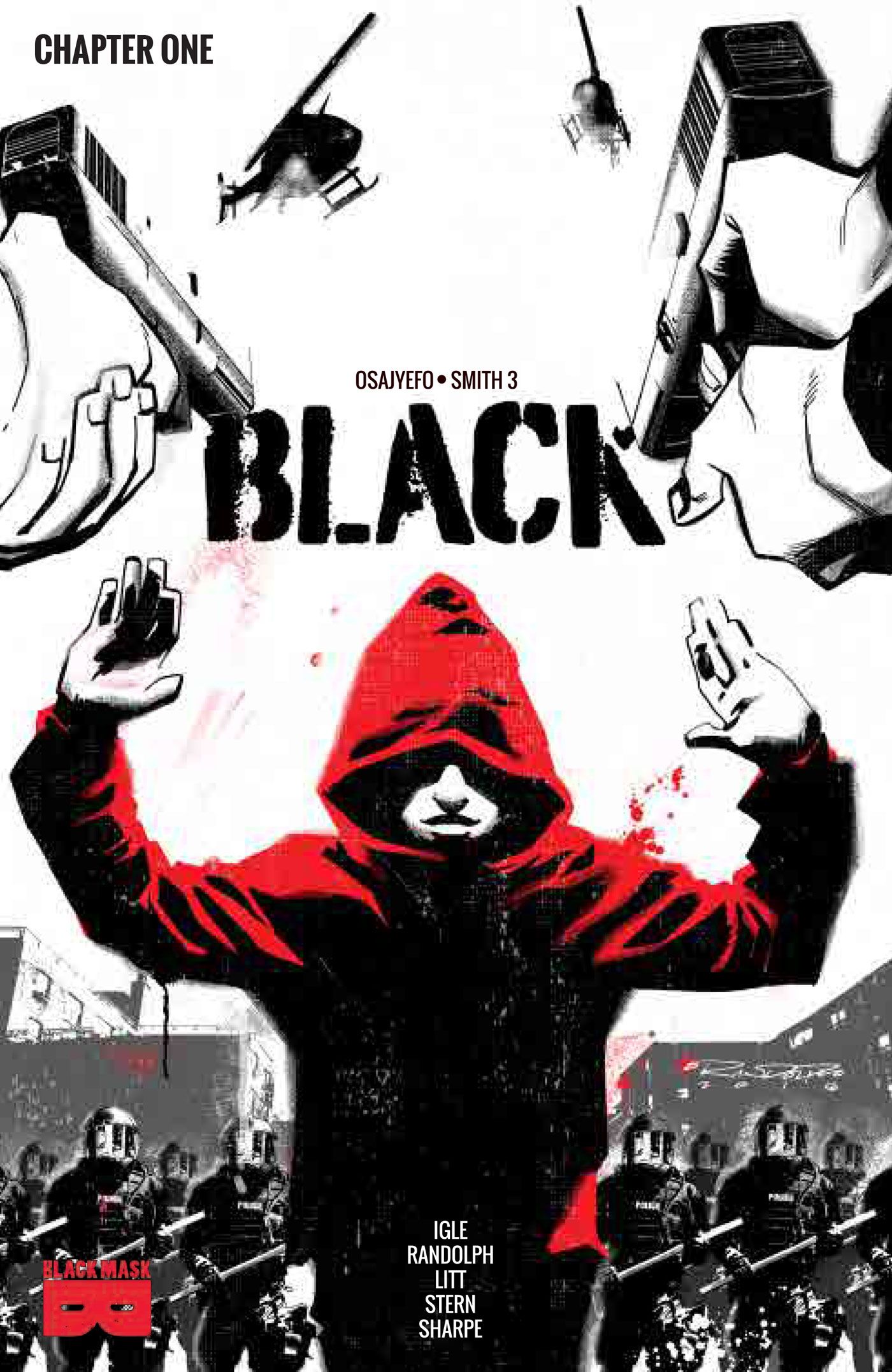Kareem Jenkins is a young black man in New York City. He’s not a saint, but he’s a pretty good guy overall. Unfortunately, one day he’s in the wrong place at the wrong time and, bang! He’s dead, gunned down by an overzealous and scared police officer. Game over.
Except -- it’s not. Kareem wakes up and finds that he can do things he never imagined possible. Now, with everyone out to get him and show him that there is much more to the world than he ever realized, he has to ask himself what he wants to do about the state of that world.
Welcome to “Black,” a new series from writer Kwanza Osajyefo, designer Tim Smith 3, artists Jamal Igle, Khary Randolph (covers), Sarah Stern (tones), and editor Sarah Litt. In “Black,” black men can develop superpowers. The series' creators imagine how the world would react -- and how those black men might respond.
Created by Osajyefo, a former editor at DC Comics’ Zuda imprint, and Smith 3, “Black” launches from a monumentally successful Kickstarter campaign, is currently available digitally, and arrives in stores in September from Black Mask Studio.
CBR News spoke Osajyefo and Smith 3 about the new series, including Kickstarter success, why institutionalized racism should be separated from true evil, and how this series really isn’t particularly timely.
CBR News: What can you tell us about your main character, Kareem?
Kwanza Osajyefo: I think of Kareem as your average black teenager growing up in an urban U.S. environment. He’s very loosely based on a cousin of mine by the same name. He’s an orphan, has had some tragedies in life, but despite them tries to be a decent kid. He’s got a few side hustles, so if you like Showtime, need candy on the subway, or want to sponsor his basketball team -- he’s got you covered.
Tim Smith 3: Kareem, to me, is the new hero lost in a world he thought he knew. When you’re a kid, everything is new and absolute. You never think that the world will change, but it does. And at a certain age when you’re older, you might think you know all there is to know about life. Kareem has all that flipped upside down. He's looking at the world through child eyes as a young man who thought he had it all figured out. He has the opportunity to make a choice with his powers. He can now reinvent himself, brand new.
He’s gunned down in a case of mistaken identity. Violence against the black community seems to reflect of a societal fear of black men, so how does the world react to black people with superpowers?
Smith 3: Kwanza will answer this one best, as he is writing this out, and I don’t want to give too much away. I’ll say that the world is never, as a whole, ready for anything to disrupt the norm. Well, most of the world. But that doesn’t mean we can’t take steps to make things better. I can only imagine that if I found out that a group of people were able to do extraordinary things and I could not, I would be concerned for myself and my family. And to double that, if it’s a group of people that’s been targeted and oppressed for years, I would either start making some new friends, or buy extra locks for my door.
Osajyefo: “Black” is a science-fiction articulation of race issues. I think that is why it immediately resonates with people as a concept -- they know the reality it is based on. If cops are scared of an 11-year-old with a toy gun, how does one deal with an adult black male that can fly and shoot lasers from his face?
And what steps are being taken to protect people like Kareem? How does he react to this?
Smith 3: I don’t want to give up too much, so I’ll let Kwanza answer this one too. [Laughs]
Osajyefo: It comes to light in the story, but you have to entertain such an idea in the context presented: if only black people had superpowers -- that has huge implications globally, economically, historically. We’ll be exploring these things in “Black.”
“Black” seems very timely given the profile of Black Lives Matter and far too many recent headlines, but these themes and this violence are nothing new. The Civil Rights Movement never really stopped, did it?
Osajyefo: The sad thing is that it isn’t timely. These issues have existed throughout U.S. history. The difference is we have documentation devices in our pocket. A woman can easily live-broadcast her boyfriend bleeding out in the driver seat his car -- with a child witnessing it in the backseat -- due to wounds inflicted by a racially biased officer.
Smith 3: That’s just it; it’s been happening for years and years. This goes back generations. It’s a new paint job on the same busted house. But the internet, cellphones, comic books (yes even comics), and overall awareness are keys to opening the door for all to see live and in primetime. It’s not just black people; it’s all kinds of people, from color to faith. Lives are affected by misunderstanding and ignorance. “Black” is a comic that builds a fantasy world from a current, yet sad, state of affairs in our country and outward. A condition that many other people of any color can relate too.
How do you confront institutionalized evil like this in a superhero-styled comic?
Osajyefo: Evil is a strong word. I don’t think the aforementioned cop I alluded to is evil; I think he is biased. Family and society impress ideas upon individuals both purposefully and passively. That’s the thing about institutionalized racism: once it reaches that level of normalcy for people, it’s hard for some to determine right from wrong. The challenge to that can be anything from protest, to policy, to revolution -- depends on what’s required.
Smith 3: First, you remember that it is a comic. And that your imagination and understanding of a comic and real life is what will make or break this superhero story. How do I confront a man-eating hot dog bent on destroying the world? One bite at a time. That is the same way I would confront evil in a comic, one page at a time, with chips and a cool beverage.
I kid a bit, but really, taking a struggle from real life and calling it out in comics is an old recipe. Everyone can identify evil. And everyone loves a hero. The formula is the same, but the way we tell it and see it play out is what makes this unique.
“Black” was initially launched as a Kickstarter campaign. You hoped for $29,999 and wound up with over $90,000. It must be incredibly gratifying to have people respond so positively, really putting their money forward in this way, to what you’re trying to do. Does it add any pressure for you?
Osajyefo: Absolutely. There’s obviously a void that publishers are now scrambling to fill, but I think they have more pressing changes internally to overcome before they can authentically produce narratives like “Black.” I feel the most pressure in producing an engaging and entertaining story, otherwise there’s no foundation to build on.
The money is mostly for the creative team, and to have a buffer. As many can attest, there are always factors you may not have considered in a Kickstarter, so it’s good to have some cushion in case the cost of postage increases.
Smith 3: It’s without question a wonderful feeling. I always put my best in all I do, so for me there is no pressure to deliver the book. But that’s not to say there are no challenges. This book has to be, in every aspect, as professionally done as possible. The quality must be on the level of any book or story one would read from any of the top publishers. And I know this has met that standard and will continue to do so. That is what I want all the wonderful Kickstarter pledgers to know. I want them to feel that what they helped us achieve was worth every penny. I am truly grateful; this would have not happened without them. And I want people who are just getting this now, at their local shop or on comiXology, to want to read more about the characters and want to buy each issue the day it comes out.
Kwanza, how have the lessons you’ve learned on the publishing side at Marvel and DC/Zuda helped bring this to fruition?
Osajyefo: It helped me build relationships with other creatives. I didn’t approach this team as a bankrolled brand, but as a friend and colleague. I’m not an ivory tower creator and I hope to never be. The camaraderie and closeness we built between creators and readers with Zuda is something both Marvel and DC could learn from. We’re all people in this industry.
You have an independent team, right down to your editor. When did Black Mask get involved as your publisher, and how has that working relationship been?
Osajyefo: That was one of the toughest parts of this endeavour. I’ve no nostalgia for print periodicals, but as a long-time fan who grew up on the medium it was hard to think of not offering it to people who are interested in this story. As former editor, I know how important it is to have one and Sarah Litt is one of the best.
We had quite a few publishers approach us, but Black Mask has the same ethos that we do. There’s no pretense, it’s punk rock -- you and your craft. Working with Black Mask is like being managed by Shep Gordon. Honest, invested, in the trenches with you -- supermensch.
Smith 3: First, I would like to say Sarah, our editor, has enhanced optic eyeballs with a bionic brain. She is amazing! The whole team, really! Everyone is amazing and works on a laser fine professional level. So working with Black Mask has been just as great because we know what feels right at this point. We know what works. And they respect our decisions and choices based on that.
Black Mask came in well after we had the core team set up. And seeing as how all of the team are pros in their own right, having BM (Black Mask) as publisher was a smooth addition. Matt Pizzolo over at BM knows his stuff! He’s great to work with and lets us work the magic he will present to the world of comics and beyond.
Tim, I’m sure a lot of readers don’t realize what a designer brings to this package, so what are your duties?
Smith 3: Ah-hmmm… well… I bring goodwill to all the boys and girls! Kidding! I flesh out the characters and help shape the world the comic lives in. I look at the overall picture. Taking huge steps back from the detail, then going into microscope levels to make sure all is in place. A designer, from my own experience, should capture the essence of the characters. I make sure that they play off each other well and compliment each other so the reader understands the relationship between them without thinking too much about how it all clicks together while at the same time make the “Black” universe look original and exciting. That's a mouthful!
And how do you work with artists Jamal Igle, Khary Randolph and Sarah Stern?
Smith 3: One of the biggest joys of working on this is seeing how Jamal and Khary interpret my designs. They both are so talented. Same for Sarah, our toner. She does a great job giving the art more dimension.
Jamal’s a terrific artist. Was he always your first choice for the art?
Osajyefo: Yes. I edited Jamal on “The Ray,” and while I was a fan before, his speed, craft and work ethic are pure professional.
Smith 3: Yup! Kwanza and I had talked this out early on. Jamal had the look for “Black.”
What’s next for each of you?
Osajyefo: I’m going to binge-read “Naruto” again, until I master Bushin no Jutsu, or build a TARDIS, because I have so many ideas for “Black” and other stories that I either need clones or time manipulation.
Smith 3: For me, open up my computer programs, sharpen my pencil, and start another round I call, “Get to work!” A place where tea is plentiful, almond butter on toasted bread is heaven to my tastebuds, and the internet knows just what I want to see for hours on end until the sun rises. That’s how I work every day.

